Event Stream Processing Market Insight, 2032
The global event stream processing market size was valued at USD 812.5 million in 2022, and is projected to reach USD 5.7 billion by 2032, growing at a CAGR of 21.6% from 2023 to 2032.
Event Stream Processing (ESP) refers to a computational approach used to analyze, process, and respond to continuous streams of data in real-time or near real-time. It involves the ingestion, filtering, aggregation, and analysis of events as they are generated or received.
The increasing volume of data generated from various sources such as IoT devices, social media, sensors, and other applications has been a major growth driver for the market. In many industries, the need for real-time decision-making has become crucial. Businesses require immediate insights to respond swiftly to changing market conditions, customer behavior, and operational issues. Event stream processing facilitates real-time analytics, enabling organizations to make data-driven decisions quickly.
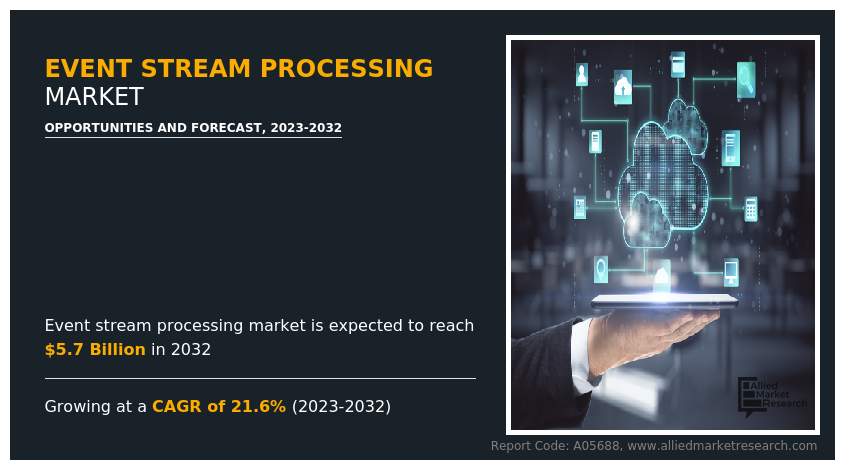
Moreover, by processing and analyzing data as it arrives, event stream processing enables businesses to derive valuable insights from streaming data in real-time. These insights are often more actionable compared to delayed or batch-processed data, leading to enhanced business value and competitive advantage. Furthermore, the proliferation of IoT devices and sensors across various domains has generated massive streams of data. Event stream processing is an essential technology to handle and analyze this continuous stream of data, unlocking its full potential for various applications, including smart cities, industrial automation, and healthcare.
Events can be any data points representing a change in state, occurrence of an action, or any significant piece of information that needs to be processed and acted upon promptly. ESP systems handle data as it arrives, enabling immediate responses to events, making them well-suited for applications requiring low latency. ESP follows an event-driven model, where data processing and actions are triggered by the occurrence of specific events or patterns.
Event stream processing indeed presents certain challenges and constraints, particularly in the areas of complexity and scalability. Implementing ESP solutions can be intricate and demanding. Building a reliable and efficient event processing pipeline requires expertise in data engineering, stream processing frameworks, and distributed systems. Configuring and optimizing ESP platforms to suit specific use cases can be time-consuming and resource-intensive.
Moreover, as data volumes and event rates increase, ensuring scalability becomes a significant concern. ESP systems need to handle and process a growing number of events in real-time while maintaining low latency. Scaling horizontally to accommodate additional data sources and processing power can be challenging and may require careful design considerations. Furthermore, high-throughput data streams require near-real-time or low-latency processing. ESP systems need to process events quickly, making timely decisions and delivering insights in a responsive manner. ESP systems rely on continuous streams of data, and ensuring data quality and integrity is crucial for generating accurate insights and avoiding errors in processing.
ESP allows organizations to make critical decisions in real-time as data is continuously analyzed and processed. This capability is especially valuable in industries such as finance, healthcare, e-commerce, and IoT, where quick responses can lead to increased revenue, cost savings, or even save lives. Furthermore, by analyzing data as it streams in, organizations can detect patterns, anomalies, and trends in real-time. This opens up opportunities for predictive analytics, enabling businesses to anticipate customer behavior, market trends, equipment failures, and others, enhancing their ability to plan and strategize effectively.
Moreover, ESP can help organizations deliver personalized and real-time experiences to their customers. For example, in online retail, ESP can analyze customer behavior as it happens and deliver personalized product recommendations, promotions, or discounts, resulting in higher customer satisfaction and increased sales. With the continuous influx of data, ESP can detect fraudulent activities, security breaches, and cyber threats in real-time. This is crucial for industries like banking, insurance, and cybersecurity, where timely detection is essential to prevent financial losses and protect sensitive data. These major factors that are projected to offer growth opportunities for event stream processing market players during the forecast period.
The key players profiled in this report include Microsoft Corporation, Google LLC, SAS Institute Inc., Oracle Corporation, TIBCO Software Inc., Impetus Technologies, Inc, Cloudera, Inc., Hazelcast, Inc., Confluent, Inc., and Amazon Web Services, Inc. Investment and agreement are common strategies followed by major market players. For instance, in May 2023, Confluent, the leading provider of event stream processing solutions, launched new features to Confluent Cloud. This technological advancement can remediate any data quality issues so that the users’ data can be relied on to make business-critical decisions.
The market is segmented on the basis of component, deployment model, application, and region. By component, the market is divided into solutions and services. By deployment model, the market is divided into cloud and on-premises. By application, the market is classified into financial services, intelligence & surveillance, healthcare, manufacturing & logistics, and retail. By region, the market is analyzed across North America, Europe, Asia-Pacific, and LAMEA.
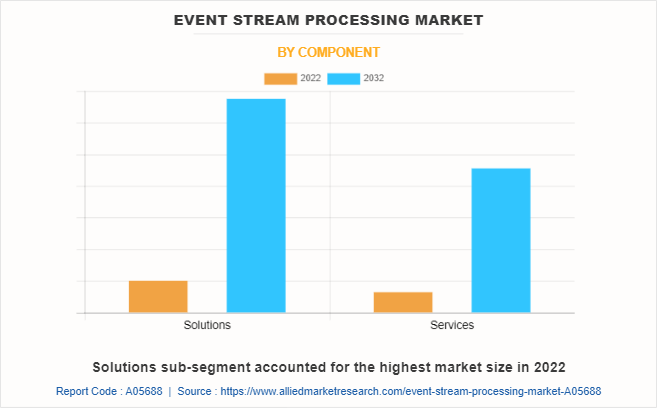
By component, the solutions sub-segment dominated the market in 2022. Event stream processing solutions refer to software systems that can analyze and process the massive volume of data in real-time in the form of event streams. Event stream processing solutions are gaining significant popularity owing to their scalability, low latency, operational efficiency, stream-line data process, event-driven architecture, and others. This is because event stream processing solutions are developed to process high-velocity event streams from various sources and scale horizontally to accommodating huge data volumes. Thus, this scalability ensures that the system can handle growing data loads without performance bottlenecks. Also, event stream processing reduces the need to store data in databases before analysis that minimizes the data storage requirements and streamlines the data processing task. In addition, event stream processing solutions can detect and track anomalies or unusual patterns in real-time data streams which helps in fraud detection and offers cybersecurity. These factors are anticipated to drive the event stream processing market opportunities in the upcoming years.
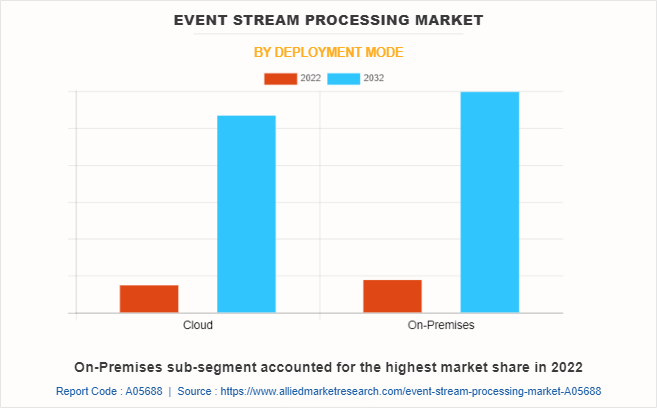
By deployment model, the on-premises sub-segment dominated the global event stream processing market share in 2022. On-premises event stream processing facilitates the deployment of event stream processing solutions within an organization's own data center or infrastructure rather than relying on cloud-based solutions. The on-premises event stream processing solutions is used across various sectors such as financial services, in Industrial Internet of Things (IIoT), telecommunication, and others. For instance, in IIoT, the on-premises event stream processing is used to analyze data from sensors and connected devices in real time which facilitates predictive maintenance as well as anomaly detection, and process optimization. This helps in enhancing the operational efficiency and reduces downtime. Similarly, in healthcare sector, the on-premises event stream processing is used to monitor patients in real time. For instance, the continuous data streams from medical devices are analyzed to detect critical changes in patients' conditions and alert healthcare providers promptly.
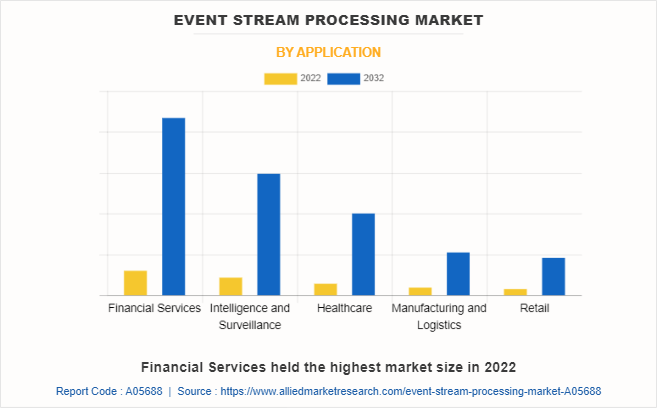
By application, the financial services sub-segment dominated the global event stream processing market revenue in 2022. In the financial services sector, event stream processing solutions are used for real-time trading, fraud detection, market surveillance, offering personalized customer experiences, and others. For instance, in the financial markets, even a slight delay in processing information can lead to missed opportunities. With the use of event stream processing financial institutions can analyze market data and news in real time which can lead to rapid trading decisions thereby improving competitiveness. Also, event stream processing reduces the time between data generation and decision-making. For instance, it enables financial institutions to respond quickly to changing market conditions such as executing trades and managing risks.
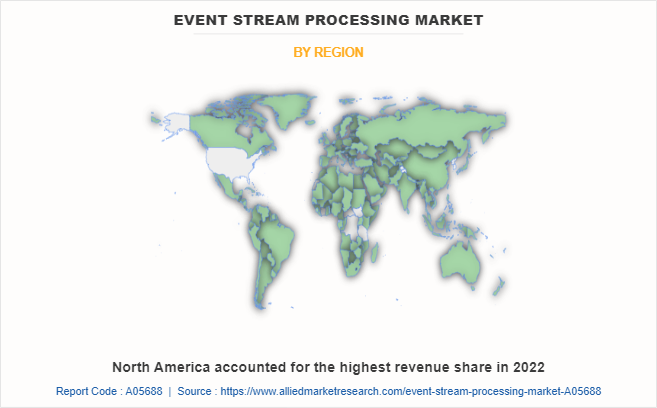
By region, North America dominated the global market in 2022. The event stream processing industry is booming in North America for various reasons such as the region's dynamic business landscape and technology-driven industries. For instance, the U.S. is a global technology hub with a thriving tech industry. Also, the country is home to numerous tech companies as well as startups, and research institutions that actively drive innovation in event stream processing and related technologies. In addition, several industries in North America including finance, e-commerce, retail, healthcare, and others rely on real-time data analytics for driving critical business decision. Owing to the same, the event stream processing enables organizations operating in these sectors to process and analyze massive amounts of data in real time and to gain valuable insights.
Impact of COVID-19
- The COVID-19 pandemic had a significant impact on the market. Many industries realized the importance of real-time data processing during the pandemic to respond rapidly to changing circumstances. This demand has boosted the adoption of event stream processing solutions.
- COVID-19 accelerated the digital transformation efforts of businesses across industries, leading to increased investments in technologies like event stream processing to optimize operations and enhance customer experiences. The impact on the market varied depending on the industries served. For example, industries like healthcare, finance, and e-commerce experienced an increase in demand for real-time data processing to handle surging workloads during the pandemic.
- Some companies faced financial constraints during the pandemic, leading to delayed or reduced technology investments, which affected the market growth to some extent. The pandemic caused disruptions in global supply chains, affecting the manufacturing and distribution of technology products, including ESP platforms and hardware. This led to delays or changes in the adoption of such solutions.
Key Benefits for Stakeholders
- The report provides exclusive and comprehensive analysis of the global market trends along with the event stream processing market forecast.
- The report elucidates the event stream processing market opportunity along with key drivers, and restraints of the market. It is a compilation of detailed information, inputs from industry participants and industry experts across the value chain, and quantitative and qualitative assessment by industry analysts.
- Porter’s five forces analysis helps analyze the potential of the buyers & suppliers and the competitive scenario of the market for strategy building.
- The report entailing the event stream processing market analysis maps the qualitative sway of various industry factors on market segments as well as geographies.
- The data in this report aims on market dynamics, trends, and developments affecting the growth of the market.
Event Stream Processing Market Report Highlights
| Aspects | Details |
| Market Size By 2032 | USD 5.7 billion |
| Growth Rate | CAGR of 21.6% |
| Forecast period | 2022 - 2032 |
| Report Pages | 290 |
| By Component |
|
| By Deployment Mode |
|
| By Application |
|
| By Region |
|
| Key Market Players | Cloudera, Inc. , TIBCO Software Inc., Microsoft Corporation, Confluent, Inc. , Impetus Technologies, Inc., Amazon Web Services, Inc., Google LLC, SAS Institute Inc., Hazelcast, Inc. , Oracle Corporation |
The global event stream processing market size was valued at $812.5 million in 2022, and is projected to reach $5.7 billion by 2032
The event stream processing market is projected to grow at a compound annual growth rate of 21.6% from 2023 to 2032.
Microsoft Corporation, Google LLC, SAS Institute Inc., Oracle Corporation, and TIBCO Software Inc. are the major players in the event stream processing market.
Asia-Pacific is projected to provide more business opportunities for the global event stream processing market in the future.
The demand for real-time data analysis and insights is increasing across various industries. Event stream processing offers a solution to process and analyze vast amounts of data in real-time, enabling businesses to make informed decisions instantaneously, which is estimated to generate excellent opportunities in the event stream processing.
Loading Table Of Content...
Loading Research Methodology...


